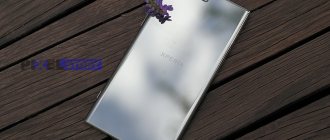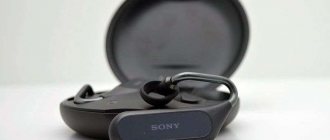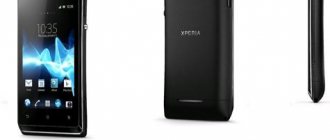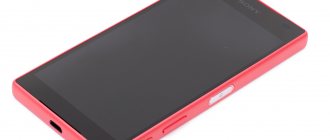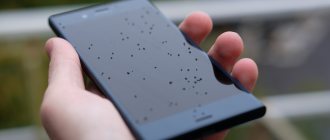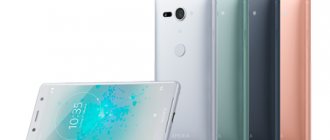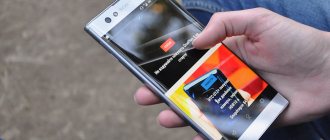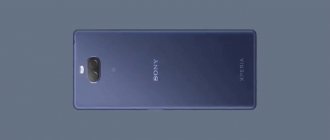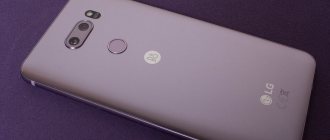Sony Xperia XZ
Of course, it’s worth starting with the Sony Xperia XZ model - this is one of the company’s hottest new products, a real flagship device.
The first thing that catches your eye is the completely new design of the case. It looks great, the body itself is metal, and fits perfectly in the hand.
Screen diagonal - 5.2 inches, processor - Qualcomm Snapdragon 820, 3 GB of RAM. There is USB Type-C, fast charging function, fingerprint scanner, 23 MP camera. In short, a powerful and cool device with all the necessary functions.
- Screen diagonal: 5.2 inches
- Screen resolution: 1920×1080
- Weight: 161 g
- Number of SIM cards: 1
- Processor: Qualcomm Snapdragon 820
- Memory capacity: 32 GB
- RAM capacity: 3 GB
- Battery capacity: 2900 mAh
- Camera: 23 MP
- Memory card support: yes
- Support for 4G networks: yes
Sony Xperia XZ1
Price: $635
- Screen: IPS, 5.2” FullHD;
- Processor: Snapdragon 835 (2.35 GHz);
- Memory: 4/64 GB;
- Camera: main – 19 MP, front – 13 MP;
- Battery: 2700 mAh.
After the summer release of the Xperia XZ Premium, the ranks of top-end phones from Sony were replenished with another model - the Xperia XZ1. The device received a display with a smaller diagonal, an all-metal body and the same productive platform. When sales started in the fall, the Xperia XZ1 also cost about $200 less than the main flagship. In general, the company is positioning this device as a cross between flagships and mid-priced devices.
Unlike the Sony Xperia XZ Premium, the smartphone is not as bulky and bright, and there is no chrome coating on the back panel. There are three body color options available for sale – black, silver and blue. There is an IP68 waterproof standard; the gadget can be safely submerged under water to a depth of one meter. From the flagship Xperia XZ1 also inherited stereo speakers located above and below the display.
The screen itself has a FullHD resolution with a diagonal of 5.2 inches, and a pixel density of 424 units per inch. Against the background of the rectangular shape of the device, this format looks best, since the display in the XZ Premium was still too large. The only drawback of the screen is a slight color distortion towards warm colors at maximum viewing angles.
By the way, the Xperia XZ1 out of the box runs the Android 8.0 operating system with minor cosmetic additions from Sony. The core of the device is the current top-end processor Snapdragon 835 and the Adreno 540 graphics accelerator. According to the results of synthetic tests, the Xperia XZ1 lags quite a bit (8 thousand points in AnTuTu) behind the flagship Xperia XZ Premium. But the lag in autonomy is already more noticeable; towards the evening there is practically nothing left of the charge of the thin 2700 mAh battery.
Conclusion: Sony Xperia XZ1 is a slightly improved version of the company's flagship. Yes, the smartphone has a lower display resolution, but it itself is almost $250 cheaper than the top-end Sony phone.
Sony Xperia XZ1
Sony Xperia Z5 Premium Dual
Premium version of the Xperia Z5 model. It uses a 5.5-inch screen, and the resolution is surprising - 3840x2160 pixels! True, it is not entirely clear why the company took such a step, even if QHD resolution with such a diagonal is quite enough, but the fact is a fact.
The smartphone is built on the Qualcomm Snapdragon 810 processor, has 3 GB of RAM, 32 GB of internal memory. Camera - 23 MP.
The smartphone looks very nice - stylish and strict. The color of the case can be chosen to suit your taste.
- Screen diagonal: 5.5 inches
- Screen resolution: 3840×2160
- Weight: 180 g
- Number of SIM cards: 1
- Processor: Qualcomm Snapdragon 810
- Memory capacity: 32 GB
- RAM capacity: 3 GB
- Battery capacity: 3430 mAh
- Camera: 23 MP
- Memory card support: yes
- Support for 4G networks: yes
New Japanese flagship: review of the Sony Xperia X smartphone
Last week, the new Sony Xperia X arrived in Russia. Despite the fact that this is not the brand’s most expensive smartphone, the model can be called the Japanese flagship of 2020, since it is the company’s main focus. What is interesting and not interesting about the new product from Sony? Is it worthy of users' attention? Read about this in the material of m24.ru columnist Dmitry Bevza.
In 2020, Sony confused everyone: both ordinary mobile technology enthusiasts and professional reviewers. Instead of the familiar Z series, three smartphones of the new X series were presented at the Mobile World Congress in Barcelona: the most expensive Xperia X Performance, its cheaper twin brother Xperia X and the younger model Xperia XA.
At first, everyone decided that these devices would replace the top-end Z-series, but as Sony assured, the X series will be the main one only this year. What will happen next is not very interesting now, the main thing is the fact: these three devices will be the leading Japanese smartphones in 2020.
Why is Russia focusing on the Xperia X and not on the Xperia X Performance? The main thing is the price. Xperia X is cheaper. Pre-orders have already been announced for it in Russia. Price: 39990 rub. Not to say that it is cheap, but the amount is quite competitive compared to the flagship devices of competitors.
It remains to be seen what we get for this money.
Brief technical specifications
- Memory and Storage: RAM: 3 GB Flash memory up to 32 GB (single SIM model) 64 GB (dual SIM model) MicroSD card slot up to 200 GB
- Processor: Qualcomm® Snapdragon 650
- Battery: 2620 mAh
- Display: 5-inch Full HD display, 1080p
- Main camera: 23 MP 1/2.3" Exmor RS for mobile Intelligent Hybrid Autofocus, 5x Clear Image Zoom, 24mm Wide Angle G Lens with F2.0 aperture
- Front camera: 13 MP 1/3-inch Exmor RS sensor for mobile 22mm wide-angle lens with F2.0 aperture
- Weight: 152 grams
- Dimensions: 143 x 69 x 7.7 mm
Almost all smartphone manufacturers and independent analysts regularly conduct their research on what is most important to the user when purchasing and subsequently using a smartphone.
The result for everyone is approximately the same, and the list of consumer preferences looks like this: brand, price, screen, camera, battery life, and to a lesser extent design and performance. Why is design and performance less of an interest to users than before?
Taking into account the greatly increased performance of mobile processors in recent years and the limited number of user tasks that can be solved using a smartphone, now even mid-priced devices are equipped with very powerful chipsets. Their performance is enough to solve 90 percent of problems. If you do not play the latest games with complex graphics, then it is simply impossible to distinguish by eye the speed of a mid-level processor from top models.
The Xperia X is powered by a six-core Qualcomm Snapdragon 650 chipset and 3GB of RAM. This is a new generation of chipsets from Qualcomm in the mid-price category with a fairly powerful Adreno 510 video chip. It is still difficult to imagine scenarios for using a smartphone in which this technical solution could have problems due to lack of performance.
Audiophiles will be interested in the fact that the Xperia X can handle high-resolution Hi-RES files. True, to appreciate the beauty of this function, you will have to buy headphones that cost no less than the smartphone itself. So Hi-RES support is a nice audio option, but useless for most users.
Design and ergonomics
Appearance is an important thing, but most users believe (generally rightly) that smartphones from different brands have become very similar to each other. Yes, sometimes through the monstrous efforts of technologists and designers of a particular company, something interesting and successful is invented, but such solutions are quickly copied by competitors and cease to be unique. Given this state of affairs, it is not surprising that when assessing the appearance of a smartphone, users only pay attention to the color and material of the case.
It must be admitted that the design of Sony Xperia smartphones still has its own characteristics, which the company clearly values. The new model has a matte metal body, a now fashionable 2.5D glass screen with curved edges, and four color options: black, white, yellow-green, pink.
A distinctive feature of the “Japanese” is the unusual arrangement of control buttons. The fingerprint sensor, used to unlock the smartphone, is combined, as usual, with the on/off button. The interesting thing here is that it is not located under the screen, but on the right side. This is a proprietary Sony solution, and a very successful one at that.
Screen
The Xperia X features a five-inch IPS display with a resolution of 1080x1920 (FullHD). The screen is good, but in terms of contrast and brightness it is still inferior to the latest Super AMOLED screen of the Samsung Galaxy S7. However, even under direct rays of the bright summer sun, the display is perfectly readable.
Of course, the Xperia X has adaptive screen brightness adjustment depending on external lighting. In the settings you can enable the X-Reality option. This is Sony's proprietary software technology, which visually enhances photos and videos, but at the same time slightly increases battery consumption.
Camera
Sony has always had a rocky relationship with smartphone cameras. On the one hand, Sony is the world's leading manufacturer of smartphone photo modules. They are installed in millions of devices from other vendors. Sony also has extensive experience in creating high-quality professional video and photo cameras.
On the other hand, often Sony photo modules found in competitors’ smartphones worked better than the same cameras in Sony Xperia smartphones. This seems strange only at first glance. A good smartphone camera is not only about high-quality hardware, but also about image processing software algorithms, which Sony's were not as good as some of their competitors. Last year, the company's management, realizing the absurdity of this state of affairs, attracted large internal resources to eliminate the backlog in this area.
What can you say about the X Xperia camera after several days of using the smartphone? I liked the camera. 23 megapixels. G Lens, fast (0.03 sec.) hybrid predictive autofocus, which tracks moving objects, analyzes the nature of the movement, predicts where the object will be in the next second and focuses exactly on this place. The camera itself “wakes up” very quickly, in 0.6 seconds, and shoots well both on full automatic, in the “point and click and forget” style, and with preset shooting modes.
Pre-installed modes and additional photo applications can be downloaded from the Google Play store. At the same time, they are integrated directly into the camera interface.
Below are examples of how the Xperia X camera works in different modes. All photos are published without post-processing in a photo editor. That is, you see exactly what happened as a result of the shooting.
Auto mode
Landscape
Defocus background
Backlight
Night
Sony’s traditional “augmented reality” set. Looks pretty funny.
There were no special complaints about the video mode. Accelerated, slow motion - it's all there. Do microphones work in the wind? Despite digital noise reduction, alas, no miracle happened. Like most competing smartphones, there is still a problem with this one.
The Xperia X does not have optical stabilization. It is usually needed when shooting video and at long camera shutter speeds, for example, at night. The Xperia X has proprietary digital SteadyShot stabilization, which helps compensate for camera shake when shooting handheld, but as you can see from the night shot, it doesn't always cope with it.
A separate conversation about the front camera. The Xperia X's selfie camera is simply fire. The Japanese approached the matter thoroughly and equipped the device with a 13-megapixel selfie camera. 13 megapixels is a lot!
Battery life
The battery capacity of Xperia X is 2620 mAh. Decent, but not record numbers. The most interesting thing here is the optimization of the hardware and applications. The company claims that Xperia X can work up to two days without recharging. However, let’s make a reservation right away: in order to achieve this, you need to do some magic with the smartphone’s settings: adjust the power consumption and use the special Stamina mode, which limits some background processes of the smartphone. If all these manipulations are not performed, the battery lasts for about a day.
Flaws
During testing, we did not find any obvious shortcomings in the Xperia X. But there is something to complain about.
Firstly, it’s a pity that, unlike the Z series, the Xperia X is not a waterproof device.
It was never possible to completely remove the main camera into the body. It sticks out a little.
When shooting at night, digital stabilization does not always compensate for hand shake and the frames may turn out blurry.
As for ergonomics, not everyone likes the specific location of the control buttons, on the lower half of the right side edge, and the mechanical camera shutter button (a kind of proprietary Sony feature). So, for example, when you take a selfie, you involuntarily press the camera shutter button. Yes, you can hold a smartphone in your hand in another way, but nevertheless there is some discomfort.
We expected more battery life from the battery, but the effect of inflated expectations may have worked here.
And yes. Whatever Sony and other vendors think, it is obvious that the headphone output should be located not on the top edge of the smartphone, but on the bottom.
It can also be noted that the Xperia X is too similar to last year’s flagship Xperia Z5. Continuity is good, but many were expecting a more radical design update.
Results
The device turned out to be certainly interesting and balanced. Fans of the brand will definitely like it. The price also cannot be called prohibitive. In Russia, when purchasing a device, the company added a six-month subscription to the Google Play music service, the ability to download 12 movie hits for free, and an extended warranty on the screen.
In general, everything is very, very good, but we must admit that competitors are not asleep. The 2020 models of all leading brands turned out to be extremely successful. Plus, many vendors are “insidiously” lowering prices on their last year’s flagships. In general, Xperia X falls into a market niche with unrealistically high competition. The presence of which is very good for us customers.
Story: Dmitry Bevza - about gadgets and new technologies
Sony Xperia Z5 Dual
A “smaller” version of the Z5 Premium. The screen diagonal here is 5.2 inches, and the resolution is 1920x1080 pixels.
Otherwise, the devices are very similar, including characteristics. For example, the same Qualcomm Snapdragon 810 processor is used here.
Of course, the Xperia Z5 is slightly cheaper than the Xperia Z5 Premium.
- Screen diagonal: 5.2 inches
- Screen resolution: 1920×1080
- Weight: 157 g
- Number of SIM cards: 2
- Processor: Qualcomm Snapdragon 810
- Memory capacity: 32 GB
- RAM capacity: 3 GB
- Battery capacity: 2900 mAh
- Camera: 23 MP
- Memory card support: yes
- Support for 4G networks: yes
Sony Xperia L1
Sony Corporation regularly tries not only to update its flagship products, but also pays attention to the budget line. At the MWC exhibition, the Sony Xperia L1 was presented, the review of which is devoted to this material. The Japanese offered buyers a good price-quality combination with average capabilities, a recognizable design, two good cameras and the new Android 7.0 Nougat OS.
The buyer has a choice of three color options for the new product:
- a strict, black gadget will emphasize the seriousness and business acumen of the owner;
- white - suitable for charming business women and those who love more delicate classics;
- pink Sony Xperia L1 will be a real find for girls who know a lot about fashion and style.
As for the exact dimensions of the product, they are as follows:
- height - 151 mm;
- width - 74 mm;
- thickness - 8.7 mm;
- weight - 180 grams.
These are fairly common weight and dimensions today, allowing the device to fit securely even in a small woman’s hand. The shape of the model is rectangular, with clear corners; the edges, on the contrary, are ergonomic, slightly rounded. The material from which this gadget is made is high-quality, matte plastic.
On the front panel, around the screen, the side frames are small and unnoticeable, but the top and bottom ones catch the eye and amaze with their hugeness. At the top, above the display, are located:
- logo;
- proximity and light sensor;
- front-camera;
- speaker
There is nothing on the bottom of the frame, so its width seems completely unjustified. Sony engineers and designers finally listened to user feedback about the inconvenience of the location of mechanical keys, and therefore now the volume rocker and on/off button are located on the top right side, unlike previous models, in which they could be found in completely unpredictable places.
Only the cover with the SIM and MicroSD tray was moved to the left side. The tray of the new Sony Xperia L1 Dual is designed for 2 nano-format SIM cards. At the bottom end you can see a slot for an external speaker, a USB Type-C input and a conversational microphone. On the top there is a standard (3.5 mm) headphone jack and an additional microphone. On the back panel in the middle we see the name of the series, and in the upper right corner there is a small camera module and a flash below it. Nothing superfluous, everything is simple and tasteful. On the negative side, a number of users have already noted in their reviews a feeling of general sloppiness in the assembly.
The device arrives to the buyer in a white cardboard box with the name of the series and the manufacturing company, which in addition to the smartphone contains:
- Charger;
- USB Type-C cable;
- all necessary paper documentation (warranty and user instructions).
If desired, you can buy a whole set of branded accessories for the Sony Xperia L1, from a SmartBand 2 bracelet with a heart rate monitor and a fitness tracker, to a charging dock, mono and stereo headsets.
As for a budget model, the screen in this case is really good. Its main parameters are as follows:
- diagonal is 5.5 inches;
- HD resolution – 1280×720 pixels.
It occupies 74.6% of the entire front surface of the device. The pixel density per inch is 267. This is average for budget gadgets, but despite this, the image is not grainy. The manufacturers of Sony Xperia L1 decided to focus on an IPS matrix during development. It gives the user an excellent picture and good viewing angles. Contrast, clarity, sharpness, detail and brightness are quite acceptable. Focusing on specific numbers:
If you wish, you can rely on automatic screen settings for different times of day and lighting, or you can adjust it yourself, based on your needs and wishes. Also, it is possible to adjust the color temperature, black and white balance. The oleophobic coating is not very good, as fingerprints still collect, but wiping them is not difficult. The sensor perceives up to five simultaneous touches.
The heart of the gadget is the 64-bit MediaTek MT6737T processor. It has four ARM Cortex-A53 cores with a clock frequency of 1.45 GHz each. A dual-core Mali-T720 MP2 graphics accelerator is also built in, the maximum frequency of which is 600 MHz. This is enough for simple games, but the Sony Xperia L1 won’t be able to handle modern resource-intensive applications, and even if it does run them, the sluggish gameplay will clearly not be enjoyable.
As for memory, everything is also very unimpressive:
- 2 GB LPDDR3 RAM.
16 GB ROM (about 10 GB data storage available). Of course, it’s enough for a small number of photos and music, but you can’t count on more.
To solve the problem with free internal memory, you can purchase and install it in the microSD slot with a capacity of up to 256 GB.
The device contains two photomodules:
- The main one is 13 MP. It has an f/2.2 aperture, autofocus and a single LED flash. The module can shoot video in FullHD resolution, 30 fps. ISO 3200. There is a 3x Clear Image zoom.
- Frontal. Five megapixel wide-angle selfie camera with f/2.2 aperture and 24mm equivalent focal length.
Among the features of the Sony Xperia L1, I would like to highlight touch focus, the possibility of panoramic shooting, reaction to a smile and face, as well as geo-tags.
The sound of the product is quite pleasant without noise or distortion; everything can be heard well in headphones and a wireless headset. There is a branded Clear Audio+ and FM tuner, stereo recording is possible. The following audio formats are supported: LPCM, FLAC, ALAC, DSD.
Sony Xperia X Performance Dual
Yes, yes, this is also a flagship device! The design of the case, it should be noted, is very interesting, but it cannot be confused with other flagships of the company.
Interestingly, the screen here has a diagonal of 5 inches, that is, Sony provides a choice for everyone - both those who need a larger screen and those who need a smaller one.
Processor - Qualcomm Snapdragon 820, RAM - the same 3 GB, built-in - 32 GB. Camera - 23 MP.
- Screen diagonal: 5 inches
- Screen resolution: 1920×1080
- Weight: 165 g
- Number of SIM cards: 2
- Processor: Qualcomm Snapdragon 820
- Memory capacity: 64 GB
- RAM capacity: 3 GB
- Battery capacity: 2700 mAh
- Camera: 23 MP
- Memory card support: yes
- Support for 4G networks: yes
It has an amazing display.
Sony introduced the Xperia 5 II, another camera phone from the Japanese brand. The device is a smaller copy of the Xperia 1 II presented in February.
The smartphone has an elongated body that has already become classic for Sony with a 6.1-inch OLED display with a resolution of 1080 x 2520 pixels. The screen has a picture refresh rate of 120 Hz and a sensor reading frequency of 240 Hz.
The flagship came with a Snapdragon 865 chip, has 8 GB of RAM and 128/256 GB of internal memory. Memory can be expanded using microSDXC memory cards.
At the back there is a triple camera with wide-angle and ultra-wide-angle lenses and a telephoto lens with a resolution of 12 megapixels each. Xperia 5 II can record 4K video at up to 120 fps.
The phone has a 4000 mAh battery with 21 W fast charging (50% in half an hour), it supports USB Power Delivery 3.0 technology. For comparison, the Xperia 1 II differs from the new product in having a larger screen (6.5 inches) and a quad camera (additional ToF sensor with a resolution of 0.3 megapixels).
Sales of the flagship will start in the fall, the cost of the Xperia 5 II is not disclosed (it will be about 900 euros). Sony Xperia 1 II can be bought in Russia for 78,990 rubles.
Subscribe to our Telegram channel - you definitely won’t miss cool news and texts
We have a top channel with discounts. Smartphones, laptops and accessories – you can save on everything
“Executioner” on VKontakte – all posts, comments and even likes
Subscribe to the “Executioner” Telegram channel – it’s cooler there than on the website. Subscribe to the “Executioner” group on VKontakte – there are no advertisements there.
Sony Sony Xperia 5 II announcement News Smartphones
The main thing on the topic “Sony”
Andrey Stavitsky
30 Sep '20
6 007
Read
Sony Xperia 5 II can already be ordered in Russia. Along with a gift
Expensive, but free headphones are good.
Andrey Stavitsky
26 Sep '20
2 664
Read
You can already pre-order the Sony PlayStation 5 in Russia. But there is a nuance
Perhaps the digital version of the console will be in short supply.
Andrey Stavitsky
17 Sep '20
1 360
Read
Sony PlayStation 5 can already be pre-ordered in Russia. The cost of gaming accessories has also been revealed.
Pay 5 thousand rubles and wait for November.
Andrey Stavitsky
17 Sep '20
1 575
Read
Russian price of Sony PlayStation 5 – wow! Games will also be more expensive than before
There is bad and good news.
Andrey Stavitsky
16 Sep '20
854
Read
The price of the Sony PlayStation 5 has been revealed. The game console will cost at least $400
We are waiting for November.
Andrey Stavitsky
07 Sep '20
7 131
Read
Sony Xperia 5 II will be released next week. We have already seen the promotional video and know the price of the flagship
Decent device.
Comments
Sony Xperia X Compact
Not quite a flagship in the current sense of the word. The fact is that the Sony Xperia X Compact is a compact model with a screen diagonal of only 4.6 inches. There are already few smartphones in this category, and there are almost no powerful devices at all. We can say that the Sony Xperia X Compact is the flagship among 4.6-inch smartphones.
Here you will find: a Qualcomm Snapdragon 650 processor, a body made of very high-quality plastic, a beautiful screen with a resolution of 1280x720 pixels, 3 GB of RAM, good battery life, a 23 MP camera.
- Screen diagonal: 4.6 inches
- Screen resolution: 1280×720
- Weight: 135 g
- Number of SIM cards: 1
- Processor: Qualcomm Snapdragon 650
- Memory capacity: 32 GB
- RAM capacity: 3 GB
- Battery capacity: 2700 mAh
- Camera: 23 MP
- Memory card support: yes
- Support for 4G networks: yes
Sony Xperia XZ1 Compact
Price: $485
- Screen: IPS, 4.6” HD;
- Processor: Snapdragon 835 (2.35 GHz);
- Memory: 4/32 GB;
- Camera: main – 19 MP, front – 8 MP;
- Battery: 2700 mAh.
The body size and display diagonal of phones have been increasing for several years now; what was once considered a phablet can now be called a compact smartphone. But what if you don't like big screens and bulky cases? The answer to this question was found in Sony; the Japanese tried to make one of the most compact flagships with the maximum possible functionality.
The Xperia XZ1 Compact is practically no different from the Xperia XZ1 in appearance; the manufacturer's proprietary proportions (sharp corners, large frames) are fully respected here. The only difference between the two devices is a significant reduction in the size of the case. If the Xperia XZ1 sometimes needed to be grabbed with a second hand, then the Xperia XZ1 Compact is quite comfortable to operate with one palm on the go.
Of course, for the sake of compactness, we had to sacrifice a very important parameter - the diagonal of the display. The Xperia XZ1 Compact screen has a diagonal of 4.6 inches with HD resolution. Don’t be upset about the last point, 1280×720 pixels look very attractive in such a small area; in terms of pixel density, Sony’s flagship is only slightly behind the iPhone 7. However, for the standard Android 8.0 interface such a diagonal is still not enough; the icons on the screen look very small.
In terms of performance, the Xperia XZ1 Compact is not much inferior to the flagship Xperia XZ Premium. The device is equipped with the same processor and graphics accelerator, and has the same amount of RAM. True, its internal storage is already half the size, but it can be easily expanded using microSD cards.
The main 19-megapixel camera has a Motion Eye sensor, which opens up a whole range of new smartphone capabilities. Firstly, it can shoot Slow-mo HD video at 960 frames per second. Secondly, the sensor automatically captures moving objects in the frame and automatically captures them before you even press the camera's shutter button. Thirdly, Motion Eye can make 3D models of faces and objects; to scan an object, you just need to circle your smartphone around it several times. The created model can be edited and printed on a 3D printer.
Conclusion: Xperia XZ1 Compact is a real gift for lovers of compact gadgets. The device is very convenient and is almost in no way inferior to the company’s other flagships.
Sony Xperia XZ1 Compact
Sony Xperia 5 - review of Sony's new unusual flagship
Sony Xperia smartphones have always stood out for their unusual design and unique features, but the latest models have begun to noticeably copy their competitors. The current line tried to return to the path of fresh solutions and introduced an unusual HDR screen in a 21:9 . There are now two top models available: the maximum 4K version of the Xperia 1 and its FHD+ iteration Xperia 5 . The latter will be discussed in this review.
The retail price for Sony Xperia 5 in Russia is 49,990 rubles.
The smartphone comes in a large white box with silver-pearl inscriptions. The package includes: the device itself, a meter-long USB Type-C cable for connecting to a PC and charging, a power adapter plug, a small USB Type-C to mini-jack adapter for connecting a standard 3.5mm headset, a user manual, product information and warranty for 1 year.
The size of the gadget is 158 x 68 x 8.2 mm, and the weight is 164 grams.
The slightly subdued glass body beautifully reflects the surroundings without distortion, but at the same time the glare is restrained. Depending on the lighting, it can appear deep blue, cyan, black or mirror gray. The build quality is top notch. Sony Xperia 5 looks expensive.
The design of the smartphone is truly unusual. CinemaWide screen is narrow and elongated. It is framed by a metal frame with a rounded profile. The smartphone fits comfortably in the hand and pleasantly cools the skin. The palm completely wraps around the body, and about ⅔ of the screen area is within easy reach of the thumb. Sony has managed to create a handset that comes close to the convenience of a classic iPhone, but still has a large 6.1 -inch display.
The smartphone was created with an eye on cinema and social network feeds. The 21:9 proportions allow you to watch movies without annoying bars at the top and bottom, and when the gadget is positioned vertically, more comments fit into the screen than usual.
the Android 9 Pie operating system, you can quickly adjust the font and icon sizes. In addition, you can enable additional vibration synchronized with sound. That is, the smartphone will create impulses when listening to music and watching videos. The feature is interesting, but very much for an amateur.
What's really impressive is the ease of use of the split-screen mode. By clicking on a special icon on the desktop, the system offers to select any two applications to open them in a split screen, which in the Xperia 5 becomes relevant thanks to the ultra-elongated display. Both applications fit into the screen without any problems, and the width of the windows can be adjusted manually by moving the slider to one side or another. The feature is especially useful when you want to play a clip on YouTube while reading news on the site through a browser (or Twitter ) on your phone without a YouTube Premium subscription.
OLED technology with HDR support is responsible for the gorgeous contrast and true blacks in the Xperia 5 . In the system menu you can enable “creator mode” with color reproduction similar to professional Sony monitors. The image is perfectly tuned - colors look natural and vibrant, peaking at around 650 nits , which is excellent for OLED displays. Watching HDR content is a real pleasure: all the accents are well placed, there are no gray spots or highlights on half the display.
The downside is that there are some stripes on the sides of the screen when watching regular 16:9 content, but due to the true blacks here, at least they don't look gray or visible at night.
In addition, the smartphone has quite noticeable frames - with a metal outline, they subtract 9 mm from the front surface at the top, 6 mm at the bottom and 3 mm at the side.
Sony Xperia 5 is protected on both sides by chemically tempered glass of the latest generation Gorilla Glass 6 , which has increased durability when dropped on hard, uneven surfaces. The device is marked with international codes IP65 and IP68 , which means it is dustproof, protected from jets and immersed in water to a depth of no more than 1 meter for up to 30 minutes.
Instead of the usual SIM card compartment with a hole, the Xperia 5 has a sealed slot on the left side that can be removed with your fingers. This is easy to do - you just need to pry a part of the body in a special niche with your fingernail and pull it towards you. There are two nanoSIM slots inside, one of which can be used to expand the internal storage. Xperia 5 supports microSD up to 512 GB . 128 GB of your own memory here .
On the right side there is a volume rocker, a side-mounted fingerprint sensor, a power button and a camera shutter button. I tested the Xperia 5 for about a month in normal mode, and during this time the sensor almost always worked like a clock, instantly “opening” the device after touching a finger. But several times after the smartphone had been idle for a long time, it might not work—you had to press the power button to wake up the system, after which the sensor would work immediately.
I also tested it with wet hands. If your fingers are just wet, then it works as usual. But if you are really very wet, then nothing happens - you need to dry your fingertip or use a password.
It is also worth noting that there are additional invisible sensors on the side ends closer to the screen. Double-tapping opens the side menu with quick access to applications. If you swipe up on the sensors, a menu for enabling split-screen mode for applications will open. Swiping down acts like a back button. To be honest, using this functionality is inconvenient - even after a month of work, I still haven’t learned how to call these menus the first time. It's easier and faster to use icons in the menu.
At the bottom end there is a USB Type-C connector, a speaker and a microphone. On top there is only a microphone. Fans of classic wired headsets are forced to use the included adapter. Either use a wireless connection (Xperia 5 supports NFC and Bluetooth 5.0 ) or buy a new USB Type-C headset.
If desired, you can display the image on any screen via a special cable.
Under the body, the designers placed a 3140 mAh battery, which is enough for a day of active use. I tested the smartphone at a temperature of 2 degrees Celsius - in half a day of photography it was discharged by 40%. Full charging from an outlet takes one and a half hours.
The sound of the Sony Xperia 5 is excellent and loud, especially if you enable Dolby Atmos . The gadget supports Hi-Res Audio , including wireless ( LPCM , FLAC , ALAC , DSD ), LDAC and DSEE HX . The latter improves old compositions using a built-in algorithm, softening some accents in the sound or making them more expressive.
Qualcomm aptX HD audio transmission technology . Supported formats: AAC (AAC-LC, AAC+, eAAC+, AAC-ELD), ALAC, AMR-NB, AMR-WB, DSD, FLAC, MIDI, MP3, PCM, Opus, Vorbis, WMA.
8MP front camera takes excellent, clear photos in both good and average lighting. It’s convenient that the smartphone will tell you if some object appears between you and the lens that interferes with shooting.
The main camera consists of three lenses of 16 mm, 26 mm and 52 mm, 12 MP each. There is dual optical zoom and a smart image stabilization system.
Photos come out with natural colors, and night shots are very atmospheric thanks to deep blacks. The smartphone doesn't try to turn night into evening, but you can manually try to pull out details in the dark.
You can also take photos with a wide-angle lens (zoom in and then tap the W ) and record crisp videos in up to 4K with HDR .
There is eye focusing. Autofocus generally works well, but when shooting photos with bokeh effect, it begins to slow down: the software that is responsible for cropping foreground edges sometimes leaves artifacts along the contour.
Otherwise, there are no complaints - the clarity is at the highest level - the cameras take excellent pictures - without pixels or dirty paint spots at any time of the day.
The system has built-in additional filters (for example, for a pencil drawing), as well as Google Lens for automatically translating inscriptions, copying text from photographs and real life, as well as identifying products and providing information on them from the Internet.
Qualcomm Snapdragon 855 processor and a Qualcomm Adreno 640 . Taking this into account and 6 GB of RAM, the smartphone turned out to be really powerful.
The test sample was typed in Antutu :
CPU : 140,144 points, GPU : 171,796 points, MEM : 55,651 points, UX : 56,346 points, Total: 423,937 points .
In games, this allows you to turn on the highest possible graphics settings with improved textures, and at the same time nothing slows down.
The mobile version of Call of Duty works perfectly. Everything in the gameplay is well adapted to the 21:9 format. Only the main menu and loading screens may surprise you with a little trimming around the edges.
World of Tanks Blitz is adapted even better - everything is evenly distributed within the screen. At maximum settings, the game runs at a smooth 60 FPS. 120 FPS mode is not available.
PUBG works fine on the “Maximum” option with HDR - the ceiling at the moment (“Ultra” settings are still not available). The controls are very smooth - the project doesn’t even freeze when loading players and the island with the plane. The interface is well adapted to the 21:9 format.
One of the most beautiful mobile games - Asphalt 9: Legends - is slightly cut off on the sides in the menu, but in gameplay it runs full screen. The graphics look incredibly spectacular - and the ultra-wide proportions of the smartphone come in very handy here. Mostly the project runs smoothly, but sometimes there is a little noticeable stutter.
The only game that couldn't run smoothly at maximum graphics settings was Fortnite . The project looks incredibly juicy, but you still have to move the sliders to control the character comfortably. The brainchild of Epic Games is perfectly adapted to the non-standard proportions of the Sony Xperia 5 - no cropping is observed at the edges of the screen, either in the menu or during gameplay.
I didn't find any throttling or other unpleasant things. After three hours of playing at maximum brightness, the smartphone becomes warm outside. On the left next to the cameras - a little hot. Inside, sensors record temperatures at 43 degrees for the battery and 60 degrees for the central processor.
Sony Xperia 5 supports networks J8210/J8270, J9210 GSM GPRS/EDGE (2G), bands 850/900/1800/1900 / UMTS HSPA+ (3G), bands 1, 2, 4, 5, 6, 8, 19 / LTE ( 4G) 1, 2, 3, 4, 5, 7, 8, 12, 13, 17, 19, 20, 25, 26, 28, 29, 32, 34, 38, 39, 40, 41, 46, 66, J8210: LTE(4G) Cat19/Cat13, J8270: LTE(4G) Cat19/Cat13, J9210: LTE(4G) Cat19/Cat13 single SIM, Cat18/Cat13 dual SIM, and IEEE Wi-Fi 802.11 a/b/g/n (2.4 GHz) / n (5 GHz) / ac.
The Sony Xperia 5 is a beautiful smartphone with an excellent camera, an unusual super-long screen and a built-in split-screen option. Thanks to its proportions, it is very comfortable to hold with one hand, without sacrificing a large diagonal. The magnificent screen and sound are ideal for watching movies, and the powerful hardware allows you to play with the best graphics. The only thing missing from the ideal is thinner frames at the top and bottom. Otherwise, this is a very successful model, and for the right price.
Author: ACE , editing: SkyerIst , TheTinkino .
Smartphone photo: Alexey Olkin . Moscow photo: ACE .
